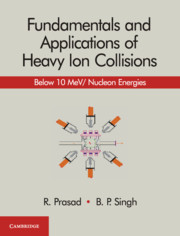4 - Measurements
Published online by Cambridge University Press: 20 October 2018
Summary
Measurement of Excitation Functions and their Analysis
In the introductory part of this monograph, it has already been mentioned that various interesting phenomena are associated with heavy ion interactions; they have attracted the attention of many researchers during the last couple of decades. In heavy ion reactions, when the projectile energy is more than the Coulomb barrier, the fusion of incident ion and target nucleus is the most likely process. The composite nucleus so formed is excited and is likely to decay initially via particle emission; when the excitation energy decreases, it decays by emitting gamma radiations. Such reactions in which the projectile completely fuses with the target nucleus are referred to as the complete fusion (CF) reactions, as already mentioned in earlier chapters. These complete fusion reactions are dominant at energies slightly above the Coulomb barrier. On the other hand, at considerably higher energies, the interaction between the incident and the target heavy ions proceeds in a different way; only a part of the incident ion fuses with the target nucleus while the remaining unfused part moves on without any interaction. This is referred to as incomplete fusion (ICF), which is likely to dominate at considerably higher incident energies. However, in recent years, it has been observed that incident ions such as 12C and 16O that have an alpha cluster structure exhibit a significant contribution of incomplete fusion (ICF) even at low energies where the CF is expected to dominate. Further, in some recent experiments where non-alpha cluster beams like 19F were used, significant contributions by ICF were observed. With the objective to study the dynamics of complete and incomplete fusion reactions in heavy ion interactions in a variety of projectile–target combinations, several experiments have been carried out using both alpha cluster as well as non-alpha cluster projectiles. Since a direct evidence of incomplete fusion may be obtained from the measurement of the excitation function of a specific reaction channel, excitation functions for a large number of reaction channels have been measured using the stacked foil activation technique. Table 4.1 lists the systems for which excitation functions have been measured, along with the energy range of study and the height of the Coulomb barrier for each system. The specified energy range covers from near the Coulomb barrier to well above it for each system.
- Type
- Chapter
- Information
- Fundamentals and Applications of Heavy Ion CollisionsBelow 10 MeV/ Nucleon Energies, pp. 131 - 248Publisher: Cambridge University PressPrint publication year: 2018

